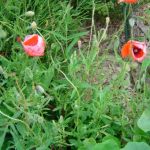| Common Name: |
Field Poppy |
| Other Names: |
Corn Poppy |
| Botanical Name: |
Papaver rhoeas |
| Genus: |
Papaver |
| Family: |
Papaveraceae |
| Native Location: |
Eurasia and N Africa, widely naturalized |
| Cultivation: |
Well-drained soil in sun. Leaves may be damaged by downy mildew. Papaver somniferum is subject to statuatory control as an illicit plant or weed in some countries, notably in the USA and parts of Australia. |
| Propagation: |
By seed sown in autumn or spring. Papaver rhoeas, P. somniferum, and their cultivars self-sow freely, but cultivars tend to revert. Poppies resent disturbance and rarely transplant successfully. |
| Harvest: |
Petals are collected as flowers open, and dried for use whole, or in infusions and syrups (P. rhoeas). Seeds are harvested from ripe capsules and dried for use whole, ground, or infusions. Oil is pressed from ripe seeds (mostly from P. somniferum). Latex (raw opium) and various alkaloids are extracted from green capsules after petal fall. (P. somniferum). |
| Height: |
20-90cm (8-36in) |
| Width: |
10-45cm (4-18in) |
| Variations: |
Mother of Pearl
Has single and semi-double flowers in pastel shades of dusky pink, lilac, gray, and pink-flushed white, often speckled and sometimes bicolored.
Height: 25-35cm (10-14cm) |
Shirley Series
Has single, semi-double, and double flowers in shades of pink, rose, salmon, crimson, and white, always with a pale center.
Height: 60cm (24in)
Width: 30cm (12in) |
|
| Hardiness: |
Hardy |
| Parts Used: |
Flowers, seeds. |
| Properties: |
A sweet, astringent, sedative herb that relieves pain, relaxes spasms, is expectorant, and improved digestion. |
| Medicinal Uses: |
Internally for irritating coughs, asthma, insomnia, poor digestion, nervous digestive disorders, and minor painful conditions (petals). |
| Culinary Uses: |
Seeds are used , whole or ground, in similar ways to those of P. somniferum. |
| Economic Uses: |
Petals of red-flowered plants are used to color medicines and wine. |
| Warning: |
All parts of Papaver species, except the seeds, are toxic if eaten. Cultivation of P. somniferum is subject to legal restrictions in some countries. |
| Bibliography: |
Encyclopedia of Herbs by Deni Brown Copyright © 1995, 2001 Dorling Kindersley Limited Pp 301-302 |
